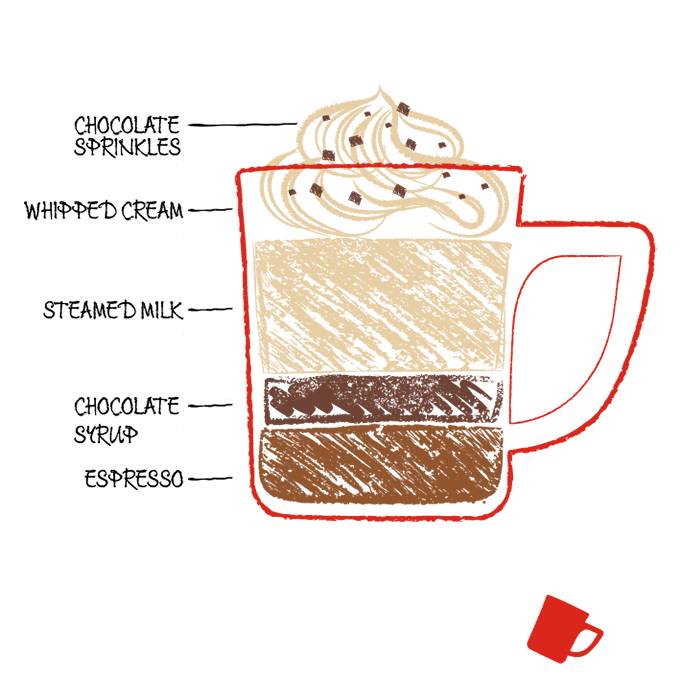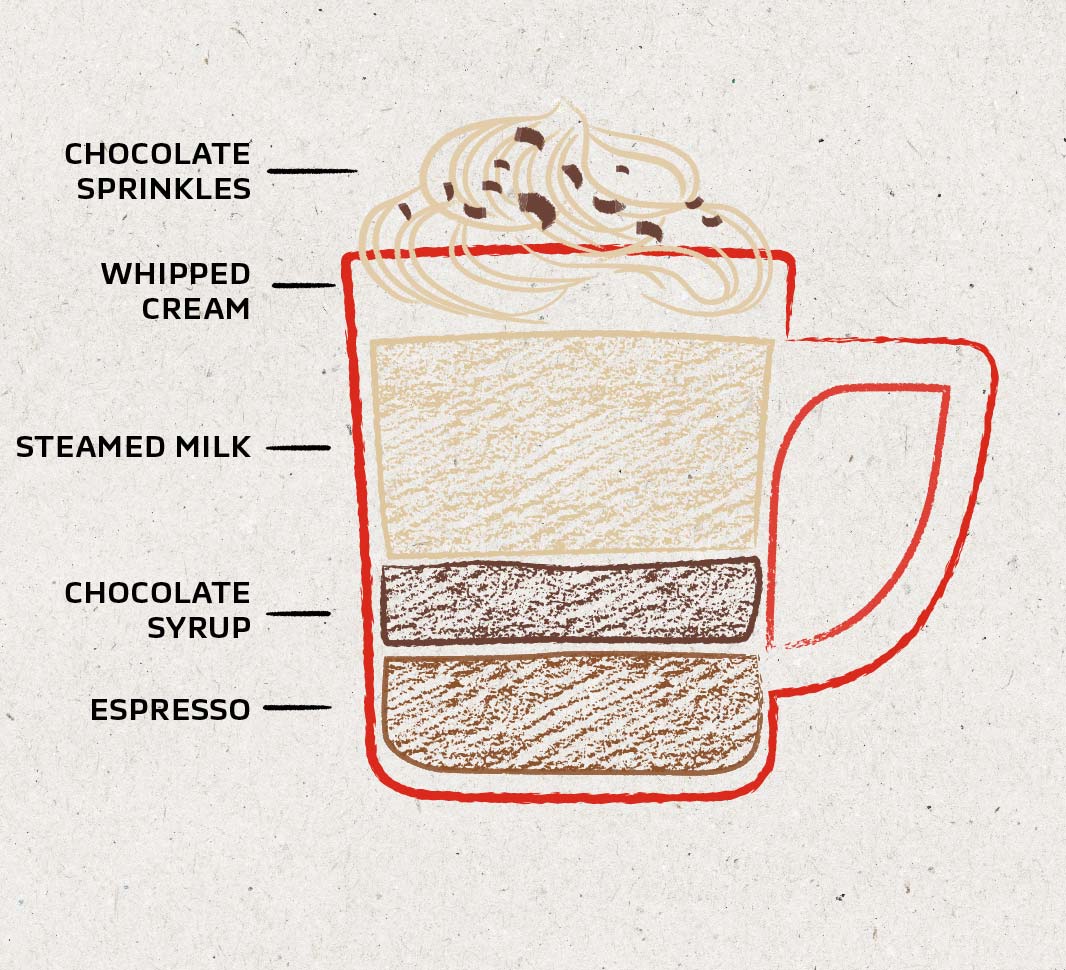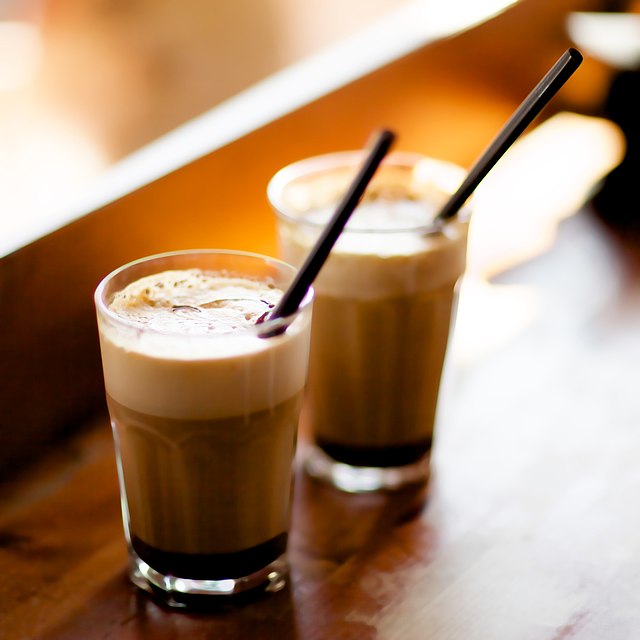As an Amazon Associate CoffeeXplore.com earns from qualifying purchases.
What Is Mocha Coffee: Ingredients, Preparation, History, and Variations
If you’re a coffee enthusiast or simply someone with a sweet tooth, you’ve likely encountered the alluring term “mocha coffee.” But what exactly is this beloved blend that seems to have everyone raving? With so many coffee options available, it can be challenging to distinguish between mocha coffee and other popular beverages.
Mocha coffee is a rich, chocolate-flavored espresso-based drink combining espresso, steamed milk, and chocolate, often topped with whipped cream.
Curious about how this delightful drink evolved from its origins in Yemen to become a global favorite? Dive into our comprehensive guide where we unravel the history, explore various recipes, and reveal tips for crafting the perfect mocha coffee at home. From understanding the fundamental ingredients to discovering unique variations, you’ll learn everything you need to make the most of this indulgent treat. Keep reading to satisfy your mocha cravings and gain insights into what sets this coffee apart from the rest.
Key Facts:
1. Mocha coffee originated from the port city of Mocha in Yemen.
2. A typical mocha contains one-third espresso and two-thirds steamed milk, with added chocolate.
3. The term “mocha” initially referred to coffee beans with natural chocolate notes.
4. Mocha can be made with various types of chocolate, including milk, dark, or white chocolate.
5. The modern mocha was popularized by Italian coffee houses in the 19th century.
What Is Mocha Coffee?

Mocha Coffee Ingredients – source
Mocha coffee is a delightful fusion of rich espresso, velvety steamed milk, and indulgent chocolate. This heavenly concoction is often crowned with a dollop of whipped cream, creating a perfect balance of bitter coffee notes and sweet chocolate undertones. The name “mocha” has an interesting origin, stemming from the port city of Mocha in Yemen, renowned for its unique coffee beans with natural chocolate flavors.
The basic ingredients of a mocha coffee include:
- Espresso
- Steamed milk
- Chocolate (syrup, powder, or melted)
- Optional toppings (whipped cream, chocolate shavings)
The proportions typically follow a 1:2:1 ratio of espresso, steamed milk, and chocolate, though variations exist depending on personal preference and specific recipes.
How Mocha Coffee Differs from Other Coffee Drinks
While mocha shares similarities with other popular coffee beverages, it stands out due to its chocolate component. Here’s how it compares to some common coffee drinks:
| Coffee Drink | Main Ingredients | Unique Characteristic |
|---|---|---|
| Mocha | Espresso, steamed milk, chocolate | Chocolate flavor |
| Latte | Espresso, steamed milk | No chocolate, more milk |
| Cappuccino | Espresso, steamed milk, milk foam | Frothy top layer |
| Americano | Espresso, hot water | No milk or chocolate |
As you can see, the addition of chocolate is what truly sets mocha apart from its coffee cousins. This unique blend creates a richer, more indulgent experience that appeals to both coffee lovers and those with a sweet tooth.
Common Misconceptions About Mocha Coffee
Despite its popularity, there are several misconceptions about mocha coffee that often lead to confusion:
- “Mocha” refers to a type of coffee bean: While the term originally referred to beans from Yemen, today it primarily describes the chocolate-coffee beverage.
-
Mocha is the same as hot chocolate: Although both contain chocolate, mocha includes espresso, making it a true coffee drink.
-
All mochas use dark chocolate: Mochas can be made with various types of chocolate, including milk, dark, or even white chocolate.
-
Mocha is always served hot: Like many coffee drinks, mocha can be enjoyed hot or iced, depending on preference.
-
Mocha is too sweet for “real” coffee drinkers: The sweetness of a mocha can be adjusted to suit individual tastes, making it enjoyable for all coffee enthusiasts.
Understanding these distinctions helps appreciate the unique character of mocha coffee and its rightful place in the diverse world of coffee beverages.
The History and Origins of Mocha Coffee
The story of mocha coffee is as rich and complex as its flavor profile. This beloved beverage has roots that stretch back centuries, intertwining with the history of coffee itself.
The Origin of the Term “Mocha”
The term “mocha” originates from the port city of Al Mokha (also spelled Mocha) in Yemen. During the 15th to early 18th centuries, Al Mokha was the primary marketplace for coffee, particularly for coffee from the mountainous regions of Yemen. These Yemeni coffee beans were known for their distinctive chocolate-like flavor notes, which is believed to be the reason why chocolate-flavored coffee drinks are now called “mocha.”
Mocha, Yemen: The Birthplace of Mocha Coffee
Al Mokha’s significance in coffee history cannot be overstated. The city’s strategic location on the Red Sea made it a crucial port for the coffee trade, connecting Yemen’s coffee-growing regions with the rest of the world. The coffee beans exported from Al Mokha were of such high quality and unique flavor that they became highly sought after across Europe and beyond.
Fun Fact: The coffee plants grown in Yemen during this time were of the species Coffea arabica, which still accounts for about 60-70% of global coffee production today!
The Evolution of Mocha Coffee in Europe
As coffee made its way to Europe in the 17th century, so did the distinctive beans from Al Mokha. European aristocrats developed a taste for mixing coffee with chocolate, laying the groundwork for what we now know as mocha coffee. This trend gained popularity, particularly in Italy, where the art of coffee-making was being refined.
By the 19th century, Italian coffee houses began incorporating chocolate into their espresso drinks, giving birth to the modern mocha. This innovation coincided with advancements in chocolate production, making it easier to blend chocolate with coffee consistently.
The Spread of Mocha Coffee Around the World
From its roots in Yemen and its evolution in Europe, mocha coffee has spread to become a global favorite. Today, you can find mocha on the menu of virtually every coffee shop around the world, from small independent cafes to large chains like Starbucks.
The popularity of mocha has led to numerous variations and adaptations across different cultures:
- In the United States, mocha often refers to a latte with chocolate syrup added.
- In some parts of Europe, “cafe mocha” might be served as espresso with hot chocolate.
- In Southeast Asia, iced mocha has gained immense popularity as a refreshing treat in hot climates.
This global spread has solidified mocha’s place in coffee culture, making it a beloved choice for coffee enthusiasts and casual drinkers alike.
Ingredients of Mocha Coffee

Mocha Coffee Cup Illustration – source
The magic of mocha coffee lies in its perfect blend of ingredients. Let’s break down each component and understand its role in creating this delightful beverage.
Espresso: The Coffee Base
At the heart of every mocha is a shot (or two) of espresso. Espresso forms the robust coffee foundation that gives mocha its characteristic kick. Here’s what makes espresso crucial:
- Intensity: Espresso provides a strong coffee flavor that can stand up to the sweetness of chocolate.
- Crema: The golden layer on top of espresso adds richness to the overall texture.
- Caffeine Boost: A standard shot of espresso contains about 63 mg of caffeine, giving mocha its energizing quality.
“The quality of espresso can make or break a mocha. A well-pulled shot with a good crema is essential for a balanced flavor profile.” – Barista World Champion, James Hoffmann
Types of Chocolate Used in Mocha Coffee
The choice of chocolate significantly influences the flavor profile of a mocha. Here are some common options:
- Cocoa Powder: Provides a pure chocolate flavor without added sweetness.
- Chocolate Syrup: Offers convenience and consistent sweetness.
- Melted Chocolate: Gives a rich, intense chocolate flavor.
- White Chocolate: Creates a sweeter, creamier mocha variant.
- Dark Chocolate: Adds depth and bitterness to balance the sweetness.
Each type of chocolate brings its unique characteristics to the mocha, allowing for a wide range of flavor variations.
The Role of Milk in Mocha Coffee
Milk is the binding ingredient that brings together the coffee and chocolate flavors in a mocha. Here’s why milk is crucial:
- Texture: Steamed milk creates a creamy, velvety texture.
- Temperature: Hot milk helps melt the chocolate and blend the flavors.
- Flavor Balance: Milk softens the bitterness of espresso and sweetness of chocolate.
Different types of milk can be used, including whole milk, skim milk, or plant-based alternatives like almond or oat milk, each imparting its unique flavor to the mocha.
Optional Toppings and Additions
While not essential, toppings and additions can elevate a mocha from great to extraordinary:
- Whipped Cream: Adds a luxurious, creamy top layer.
- Chocolate Shavings: Enhance the chocolate flavor and provide visual appeal.
- Marshmallows: Offer a sweet, gooey contrast to the coffee.
- Flavored Syrups: Allow for customization (e.g., peppermint mocha, caramel mocha).
- Spices: Cinnamon or nutmeg can add warmth and complexity.
These additions not only enhance the flavor but also contribute to the overall mocha experience, making each sip a delightful indulgence.
How to Prepare Mocha Coffee
Creating the perfect mocha coffee at home is an art that combines precision with creativity. Whether you’re a coffee connoisseur or a beginner barista, following these steps will help you craft a delicious mocha that rivals your favorite coffee shop’s version.
Step-by-Step Guide to Making Traditional Mocha Coffee
- Prepare the Espresso:
- Grind fresh coffee beans.
- Use an espresso machine or stovetop espresso maker to brew a shot (about 1 oz) of espresso.
- Heat and Froth the Milk:
- Heat 6-8 oz of milk until steaming (about 150°F).
- Use a milk frother or whisk to create a creamy texture.
- Add Chocolate:
- Mix 1-2 tablespoons of chocolate syrup or cocoa powder with the hot espresso.
- Stir until fully dissolved.
- Combine Ingredients:
- Pour the chocolate-espresso mixture into a mug.
- Slowly add the steamed milk, holding back the foam with a spoon.
- Top it Off:
- Spoon the milk foam on top.
- Optional: Add whipped cream and a sprinkle of cocoa powder or chocolate shavings.
Pro Tip: For a richer flavor, try melting dark chocolate directly into the hot espresso instead of using syrup or powder.
Tools and Equipment Needed for Preparation
To make a great mocha at home, you’ll need:
- Espresso Machine or Moka Pot
- Milk Frother or Steam Wand
- Coffee Grinder (for fresh beans)
- Kitchen Scale (for precise measurements)
- Thermometer (to monitor milk temperature)
- Stirring Spoon
- Mug or Glass (preferably pre-warmed)

Mocha Coffee Preparation – source
Tips for Perfecting the Mocha-Making Process
- Use Quality Ingredients: Start with freshly roasted coffee beans and high-quality chocolate for the best flavor.
-
Temperature Matters: Heat milk to about 150°F (65°C) for optimal sweetness and texture. Overheating can scald the milk and ruin the flavor.
-
Experiment with Ratios: Adjust the coffee-to-chocolate ratio to suit your taste preferences. A common starting point is 2 parts coffee to 1 part chocolate.
-
Layer Carefully: Pour the milk slowly over the back of a spoon to create distinct layers in your mocha.
-
Practice Latte Art: Once you’ve mastered the basics, try your hand at creating simple latte art designs on top of your mocha.
Common Mistakes to Avoid When Making Mocha Coffee
-
Using Old Coffee Beans: Stale beans can lead to a flat, uninspiring flavor. Always use freshly roasted beans.
-
Overheating the Milk: This can result in a burnt taste and poor texture. Use a thermometer to monitor the temperature.
-
Skimping on Chocolate Quality: Low-quality chocolate can overpower the coffee flavor and leave an artificial aftertaste.
-
Inconsistent Measurements: Use a scale for precise measurements to ensure consistency in your mochas.
-
Neglecting the Espresso: A weak or over-extracted espresso can throw off the entire balance of the drink.
By following these guidelines and avoiding common pitfalls, you’ll be well on your way to creating cafe-quality mochas in the comfort of your own home. Remember, practice makes perfect, so don’t be discouraged if your first attempts aren’t flawless. With time and experimentation, you’ll discover your perfect mocha recipe.
Variations of Mocha Coffee
The versatility of mocha coffee has led to a wide array of delicious variations, each with its unique twist on the classic recipe. Let’s explore some popular mocha variations that have captured the hearts (and taste buds) of coffee lovers worldwide.
White Mocha: The Sweet Alternative
White mocha is a delightful variation that swaps traditional chocolate for creamy white chocolate. This results in a sweeter, more mellow flavor profile that’s perfect for those who prefer a less intense coffee taste.
Key Characteristics:
– Uses white chocolate instead of milk or dark chocolate
– Often sweeter than traditional mocha
– Pairs well with flavored syrups like vanilla or caramel
Recipe Tip: To make a white mocha at home, melt 1-2 oz of white chocolate chips into your espresso before adding steamed milk. Top with whipped cream and a sprinkle of white chocolate shavings for an extra indulgent treat.
Iced Mocha: A Refreshing Take on a Classic
When the weather heats up, an iced mocha offers a cool, refreshing alternative to the hot version. This chilled beverage maintains the rich chocolate-coffee flavor while providing a refreshing kick.
How to Make an Iced Mocha:
1. Brew a strong shot of espresso and mix with chocolate syrup
2. Fill a glass with ice
3. Pour the espresso-chocolate mixture over the ice
4. Add cold milk and stir
5. Top with whipped cream and a drizzle of chocolate syrup
Fun Fact: Iced mochas have gained immense popularity in Southeast Asia, where they’re often served as a refreshing treat in hot climates.
Mochaccino: The Frothy Delight
A mochaccino is essentially a cappuccino with added chocolate, combining the frothy texture of a cappuccino with the rich flavor of a mocha.
What Sets Mochaccino Apart:
– More foam than a traditional mocha
– Often dusted with cocoa powder or cinnamon
– Balanced ratio of espresso, steamed milk, and foam
Barista Insight: “The key to a perfect mochaccino is in the milk frothing. You want to create a silky microfoam that blends seamlessly with the espresso and chocolate.” – Laura,head barista at Seattle’s Caffeine Corner.
Mocha vs. Hot Chocolate: Coffee or Chocolate?
While both mocha and hot chocolate are beloved warm, chocolatey beverages, they have distinct differences that set them apart. Mocha is a coffee-based drink, while hot chocolate is primarily a chocolate beverage. Let’s break down the key distinctions:
- Coffee Content:
- Mocha: Contains espresso as a base
- Hot Chocolate: No coffee content
- Chocolate Intensity:
- Mocha: Subtle chocolate flavor to complement the coffee
- Hot Chocolate: Robust, dominant chocolate taste
- Caffeine Levels:
- Mocha: Higher caffeine content due to espresso
- Hot Chocolate: Little to no caffeine (unless added)
- Milk Usage:
- Mocha: Steamed milk, often with a layer of foam
- Hot Chocolate: Usually made with heated milk throughout
- Customization:
- Mocha: Often customized with different syrups or toppings
- Hot Chocolate: Typically simpler, with occasional marshmallow or whipped cream additions
Flavor Profile Comparison:
| Aspect | Mocha | Hot Chocolate |
|---|---|---|
| Base | Espresso | Chocolate |
| Dominant Taste | Coffee with chocolate notes | Rich chocolate |
| Sweetness | Varies, can be adjusted | Usually sweeter |
| Texture | Smooth, sometimes with foam | Creamy and thick |
For coffee lovers who enjoy a hint of chocolate, mocha offers the perfect balance. On the other hand, hot chocolate is the go-to for those craving a pure chocolate experience without the coffee kick.

A delicious mocha coffee topped with whipped cream – source
Tip: If you’re looking for a caffeine boost with a chocolatey twist, opt for a mocha. For a soothing, caffeine-free chocolate indulgence, hot chocolate is your best bet.
Health Benefits and Considerations
While mocha coffee is undoubtedly a delightful treat, it’s essential to understand its nutritional profile and potential health impacts. Let’s dive into the benefits and considerations of this beloved beverage.
Nutritional Content of Mocha Coffee
A typical mocha coffee contains a mix of ingredients that contribute to its nutritional profile:
- Espresso: Provides antioxidants and a caffeine boost
- Milk: Offers calcium and protein
- Chocolate: Adds flavonoids and a touch of sweetness
However, the exact nutritional content can vary widely depending on the recipe and serving size. Here’s a general breakdown for a 16 oz (grande) mocha from a popular coffee chain:
| Nutrient | Amount |
|---|---|
| Calories | 370 |
| Total Fat | 15g |
| Carbohydrates | 50g |
| Protein | 13g |
| Caffeine | 175mg |
Note: These values can change based on customizations like type of milk, amount of chocolate, and additional toppings.
Caffeine Content and Its Effects
Mocha coffee packs a significant caffeine punch, primarily from its espresso base. A typical mocha contains about 175mg of caffeine, which is equivalent to nearly two cups of regular brewed coffee.
Positive Effects of Caffeine:
– Increased alertness and concentration
– Improved mood and cognitive function
– Enhanced physical performance
Potential Side Effects:
– Jitters or anxiety, especially in caffeine-sensitive individuals
– Sleep disturbances if consumed late in the day
– Increased heart rate and blood pressure in some people
A study by Johns Hopkins University suggests that moderate coffee consumption (3-5 cups per day) may have several health benefits, including reduced risk of type 2 diabetes and heart disease.
Antioxidant Properties of Mocha Coffee
Both coffee and chocolate contribute antioxidants to mocha, making it a potentially beneficial drink when consumed in moderation.
- Coffee Antioxidants: Rich in polyphenols, particularly chlorogenic acid
- Chocolate Antioxidants: Contains flavonoids, which have anti-inflammatory properties
Research Insight: A study published in the Journal of Agricultural and Food Chemistry found that coffee is one of the primary sources of antioxidants in the American diet.
Potential Health Risks and Considerations
While mocha can be part of a balanced diet, there are some considerations to keep in mind:
- High Calorie Content: A grande mocha can contain up to 370 calories, which may contribute to weight gain if consumed regularly without accounting for it in overall calorie intake.
-
Sugar Content: Many mocha recipes include added sugars, which can contribute to dental issues and other health concerns if consumed excessively.
-
Caffeine Sensitivity: Some individuals may experience adverse effects from the caffeine in mocha, including anxiety, insomnia, or digestive issues.
-
Lactose Intolerance: Traditional mochas contain milk, which may not be suitable for those with lactose intolerance. However, many coffee shops offer alternatives like soy, almond, or oat milk.
Expert Opinion: “While mocha coffee can be a delicious treat, it’s important to be mindful of its calorie and sugar content. Enjoying it in moderation as part of a balanced diet is key.” – Dr. Sarah Johnson, Nutritionist at Green Leaf Wellness Center.
Tip: For a healthier mocha experience, consider these modifications:
– Request skim milk or a plant-based alternative
– Ask for less chocolate syrup or a sugar-free version
– Skip the whipped cream topping
– Opt for a smaller size to reduce overall calorie intake
By being aware of these health considerations, you can make informed decisions about incorporating mocha coffee into your lifestyle. Remember, moderation is key to enjoying this delightful beverage while maintaining a balanced approach to nutrition and wellness.
Cultural Significance of Mocha Coffee
Mocha coffee has transcended its origins to become a global phenomenon, deeply embedded in coffee culture and popular media. Let’s explore the cultural impact of this beloved beverage.
Mocha Coffee in Coffee Culture
Mocha has played a significant role in shaping modern coffee culture, bridging the gap between traditional coffee enthusiasts and those with a sweet tooth.
- Café Menus: Mocha is a staple on most coffee shop menus worldwide, often serving as an entry point for new coffee drinkers.
-
Artisanal Craftsmanship: Baristas often showcase their skills through latte art on mochas, elevating the drink to an art form.
-
Seasonal Variations: Many cafés offer seasonal mocha flavors, like peppermint mocha during winter holidays, creating anticipation and cultural traditions.
-
Third Wave Coffee Movement: Even as specialty coffee focuses on pure, unadulterated flavors, mocha remains a beloved classic, often reimagined with high-quality chocolates and precision brewing methods.
Cultural Insight: “Mocha has become a symbol of indulgence in coffee culture. It’s often seen as a ‘treat’ coffee, blurring the lines between dessert and beverage.” – Mark Thompson, Coffee Culture Historian.
Famous Cafés and Mocha Brands Around the World
Mocha’s popularity has led to the rise of specialized cafés and branded products. Here are some notable examples:
- Caffè Mocha, Seattle: Known for their signature mocha blend using locally-sourced chocolate.
-
Chocolateria San Ginés, Madrid: Famous for their thick, rich mochas paired with churros.
-
MoMo Café, Tokyo: Offers a unique matcha-mocha fusion, blending Japanese and Western coffee cultures.
-
Ghirardelli Square, San Francisco: Home to decadent mochas made with the iconic Ghirardelli chocolate.
-
Starbucks: Their mocha offerings, including the popular Caffè Mocha and seasonal variations, have significantly contributed to the drink’s global popularity.
Brand Impact: According to a report by Grand View Research, the global ready-to-drink coffee market, which includes bottled mochas, was valued at $22.44 billion in 2019 and is expected to grow at a compound annual growth rate of 7.2% from 2020 to 2027.
Mocha Coffee in Pop Culture and Media
Mocha has made its mark in various forms of media, often symbolizing comfort, indulgence, or sophistication:
- Movies and TV Shows:
- In “The Devil Wears Prada,” the protagonist’s ability to fetch the perfect mocha latte becomes a symbol of her dedication to her demanding job.
- The TV series “Friends” frequently featured the characters enjoying mochas at Central Perk, cementing the drink’s place in 90s pop culture.
- Literature:
- In the novel “The Girl with the Dragon Tattoo” by Stieg Larsson, the protagonist’s coffee order (a mocha) is used to develop her character.
- Music:
- The song “Mocha” by Jay Som uses the drink as a metaphor for a comforting relationship.
- Social Media:
- Mocha frequently appears in Instagram posts and food blogs, often garnering thousands of likes and shares.
- The hashtag #mochacoffee has over 1 million posts on Instagram, showcasing its popularity in digital culture.
Social Media Trend: A study by Hootsuite found that food and drink posts, including artisanal coffee drinks like mochas, are among the most engaging content on Instagram.

Illustration of a mocha coffee, highlighting its cultural significance – source
Mocha in Advertising: Many coffee brands have capitalized on mocha’s popularity in their marketing campaigns. For example, Nescafé’s “Mocha Moments” campaign emphasized the drink’s role in creating cozy, shareable experiences.
The cultural significance of mocha coffee extends beyond its taste. It has become a symbol of comfort, a subject of artistic expression, and a shared experience that transcends borders. From local cafés to global franchises, from literature to social media, mocha continues to leave its mark on our cultural landscape.
FAQs About What Is Mocha Coffee?
Q: What is the difference between a mocha and a latte?
A: A mocha is an espresso-based drink that combines espresso, steamed milk, and chocolate, while a latte consists of espresso and steamed milk without chocolate. The key difference is the addition of chocolate, which gives mocha its distinctive flavor profile.
Q: Can you make mocha coffee with decaf espresso?
A: Yes, you can make mocha coffee with decaf espresso. Simply substitute regular espresso with decaf espresso in your mocha recipe. This allows you to enjoy the chocolate-coffee flavor combination without the caffeine content.
Q: What type of chocolate is best for mocha coffee?
A: The best type of chocolate for mocha coffee depends on personal preference. Dark chocolate provides a richer, less sweet flavor, while milk chocolate offers a smoother, sweeter taste. Some prefer cocoa powder for a more intense chocolate flavor. High-quality chocolate or cocoa powder generally yields the best results.
Q: How can I make a mocha coffee at home?
A: To make a mocha coffee at home:
1. Brew a shot of espresso or strong coffee
2. Mix in 1-2 tablespoons of chocolate syrup or cocoa powder
3. Add steamed milk (about 1 cup)
4. Stir well to combine
5. Top with whipped cream if desired
You can adjust the ratios to suit your taste preferences.
Q: Is mocha coffee suitable for vegans?
A: Traditional mocha coffee is not vegan due to its milk content. However, vegan mocha can be made by substituting dairy milk with plant-based alternatives like soy, almond, or oat milk, and using vegan chocolate or cocoa powder. Many coffee shops now offer vegan mocha options.
Summary
Mocha coffee, a delightful blend of espresso, steamed milk, and chocolate, has captivated coffee lovers worldwide with its rich flavor and indulgent profile. From its humble origins in Yemen to its current status as a café staple, mocha has evolved into a versatile beverage that caters to both coffee enthusiasts and those with a sweet tooth.
Throughout this exploration, we’ve uncovered the key components that make mocha unique – the perfect balance of coffee’s boldness and chocolate’s sweetness. We’ve delved into its history, preparation methods, and the myriad variations that have emerged over time. From traditional caffè mocha to innovative concoctions like white mocha and iced versions, the mocha family offers something for every palate.
We’ve also examined the nutritional aspects of mocha, highlighting both its potential benefits, such as antioxidants from coffee and chocolate, and considerations like calorie and sugar content. This knowledge empowers you to make informed choices about incorporating mocha into your lifestyle.
As we’ve seen, mocha’s influence extends far beyond the coffee cup, permeating popular culture, social media, and even shaping coffee shop trends. Its versatility and broad appeal have cemented its place in the global coffee landscape.
So, the next time you sip a mocha, remember – you’re not just enjoying a beverage, you’re partaking in a rich cultural tradition that spans centuries and continents. Whether you prefer a classic mocha or an inventive variation, there’s always room to explore and appreciate this beloved coffee drink.
What’s your favorite way to enjoy a mocha? Have you tried making one at home? Share your mocha experiences and let’s continue to celebrate this delicious fusion of coffee and chocolate!




